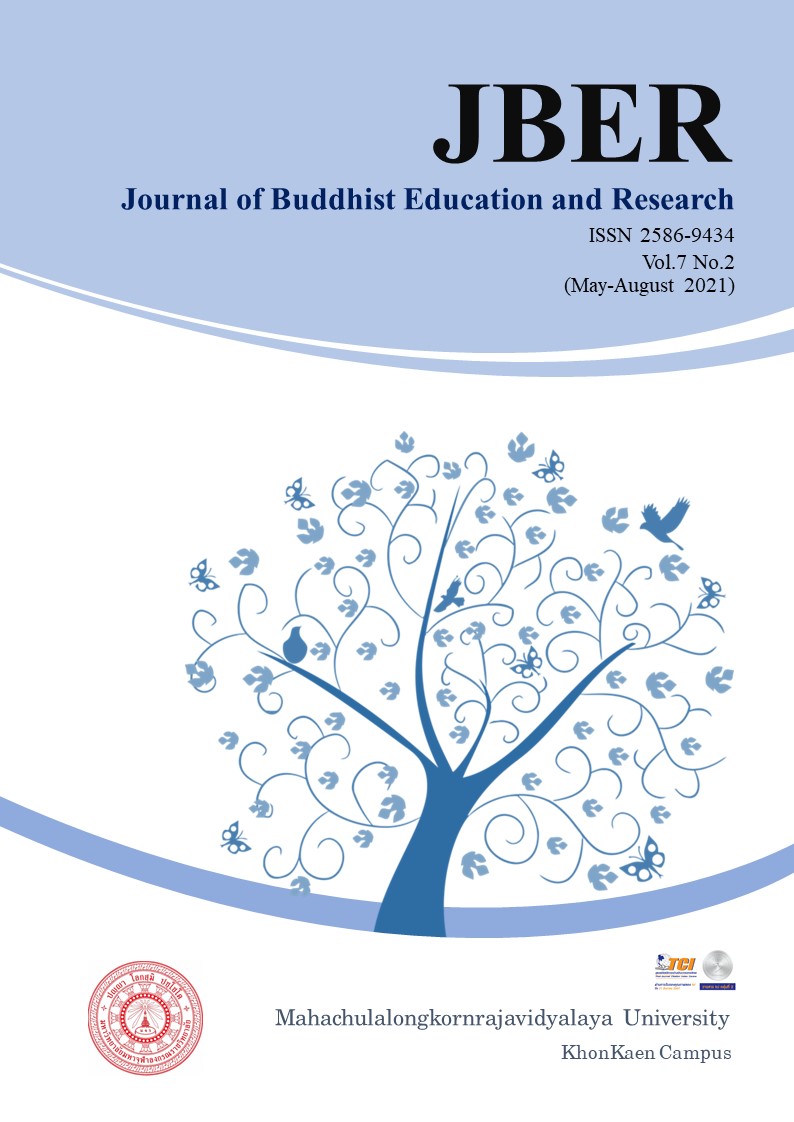THE DEVELOPMENT OF TRADITIONAL MUSIC INSTRUCTIONAL MODEL USING THE K6 MODEL, AND THE USE OF LOCAL MUSIC COMBINED WITH INTERNATIONAL MUSIC FOR STUDENTS IN MATHAYOM SUKSA 4, A GROUP OF ART LEARNING SUBJECTS (MUSIC SUBJECT), KANLAYANAWAT SCHOOL
Keywords:
Model development, Teaching style of indigenous music, K6 Model, The use of folk music mixed with international musicAbstract
This research aims to 1) To create and develop a model for teaching folk music using the K6 Model and
the use of folk music mixed with international music. For students in grade 4. 2) To study the effectiveness index of the instructional model. 3) To compare the learners' pre-school and post-study achievement.
4) To assess the satisfaction of the Mathayomsuksa 4 learners with the model teaching. 5) To assess musical skills after teaching activities.The sample group used in the creation and development of innovations were 56 students in the academic year 2020. The sample group used in this research experiment were 26 students in the Mathayom 4 academic year 2020. The research tools consisted of teaching and learning styles. Event plan learning achievement test music skills assessment form and questionnaire.The statistics used were mean, standard deviation, E1/E2, E.I. and hypothesis tested using Dependent Samples Test t-test.
The results showed that
1) The teaching and learning model of indigenous music subjects was obtained by using the K6 Model and the use of folk music in combination with international music, consisting of principles, objectives, teaching-learning processes and conditions. Applying the pattern the teaching process consists of 1) knowing the instrument. 2) know the sheet music 3) know the principles of practice 3.1) observe, perceive 3.2) follow the pattern 3.3) do it without a pattern 3.4) practice until you become proficient 3.5) measure musical skills 4) know how to maintain musical instruments 5) know how to develop skills and 6) know the teacher who teaches. The teaching model of indigenous music by using the K6 Model and the use of folk music in combination with international music. The developed efficiency was 86.45/88.83, above the 80/80 threshold. 2) The effectiveness index of the traditional music teaching model using the K6 Model and the use of folk music in combination with international music. Knowledge increased by 83.96%, which was higher than the threshold of .50.
3) After learning with the traditional music teaching model using the K6 Model and the use of folk music in combination with international music. Learners have academic achievement. statistically significantly higher than before at the .01 level.
4) The learners who were satisfied with the traditional music teaching style using the K6 Model and the use of folk music mixed with international music were at the highest level.
5) Music skill assessment found that after teaching with traditional music teaching model using K6 Model and using traditional music mixed with international music. Musical skills were assessed using the same set of assessments. Overall, it's at a high level.
References
กฤษฎา วงศ์งาม. (2562). การศึกษาเปรียบเทียบทักษะปฏิบัติ ตามรูปแบบการสอนของครูภูมิปัญญาไทยกับการสอนแบบปกติ เรื่อง ดนตรีพื้นบ้านอีสาน(พิณ) กลุ่มสาระการเรียนรู้ศิลปะสำหรับนักเรียนชั้นประถมศึกษาปีที่ 4. วิทยานิพนธ์ครุศาตรมหาบัณฑิต สาขาวิชา วิจัยและประเมินผลการศึกษา. มหาวิทยาลัยราชภัฏมหาสารคาม.
กัลยาณวัตร. (2563). รายงานการพัฒนาคุณภาพการศึกษาโรงเรียนกัลยาณวัตร ปีการศึกษา 2562. ขอนแก่น : โรงเรียนกัลยาณวัตร สำนักงานเขตพื้นที่การศึกษามัธยมศึกษา เขต 25.
คณะกรรมการการศึกษาขั้นพื้นฐาน. (2562). นโยบายสำนักงานคณะกรรมการการศึกษาขั้นพื้นฐาน ปีงบประมาณ 2563. กรุงเทพมหานคร : โรงพิมพ์ชุมนุมสหกรณ์การเกษตรแห่งประเทศไทย จำกัด.
เฉลิมศักดิ์ พิกุลศรี. (2543). สังคีตนิยมว่าด้วยดนตรีไทย. กรุงเทพมหานคร : โอเดียนสโตร์.
ชมนาด เชื้อสุวรรณทวี. (2555). การพัฒนารูปแบบการเรียนการสอนคณิตศาสตร์ เพื่อส่งเสริมความสามารถในการคิดขั้นสูงและจิตตนิสัยของนักเรียนระดับมัธยมศึกษา. วิทยานิพนธ์การศึกษาดุษฎีบัณฑิต สาขาหลักสูตรและการสอน. มหาวิทยาลัยศิลปากร.
ณรุทธ์ สุทธจิตต์. (2537). หลักการของโคดายสู่การปฏิบัติ : วิธีการด้านดนตรีศึกษาโดยการสอนแบบโคดาย. กรุงเทพฯ: สำนักพิมพ์จุฬาลงกรณ์มหาวิทยาลัย.
_______. (2540). กิจกรรมดนตรีสำหรับครู. กรุงเทพฯ: สำนักพิมพ์แห่งจุฬาลงกรณ์มหาวิทยาลัย.
พรทิพย์ สายแวว. (2559). การศึกษาผลสัมฤทธิ์ทางการเรียนและความคงทนในการเรียนรู้เรื่องโน้ตดนตรีสากลเบื้องต้น ของนักเรียนชั้นมัธยมศึกษาปีที่ 1 ที่เรียนโดยใช้บทเรียนคอมพิวเตอร์ช่วยสอน. วารสารวิชาการ มหาวิทยาลัยราชภัฏบุรีรัมย์. 8(1), 85-96.
วัจนกร สารแขวีระกุล. (2560). การพัฒนาชุดกิจกรรมเสริมสร้างทักษะปฏิบัติดนตรีโปงลาง สำหรับนักเรียนชั้นมัธยมศึกษาปีที่ 4. วิทยานิพนธ์ครุศาสตรมหาบัณฑิต สาขาวิชาหลักสูตรและการเรียนการสอน. มหาวิทยาลัยราชภัฏมหาสารคาม.
สำนักงานคณะกรรมการการศึกษาขั้นพื้นฐาน. (2563). นโยบายสำนักงานคณะกรรมการการศึกษาขั้นพื้นฐานปีงบประมาณ พ.ศ. 2563. กรุงเทพฯ: สำนักงานคณะกรรมการการศึกษาขั้นพื้นฐาน กระทรวงศึกษาธิการ.
สุกัญญา ทองทิพย์. (2558 ). แนวทางการพัฒนาสู่ความสำเร็จของวงโปงลางระดับมัธยมศึกษา ในภาคตะวันออกเฉียงเหนือ. วิทยานิพนธ์ปริญญามหาบัณฑิต. สาขาวิชาดุริยางคศิลป์. วิทยาลัยดุริยางคศิลป์ มหาวิทยาลัยมหาสารคาม.
อุทัย ศาสตรา. (2553). การศึกษากระบวนการถ่ายทอดการบรรเลงระนาดเอกของครูประสิทธิ์ ถาวร ศิลปินแห่งชาติ. วิทยานิพนธ์ปริญญาครุศาสตรมหาบัณฑิต สาขาวิชาดนตรีศึกษา. จุฬาลงกรณ์มหาวิทยาลัย.
Davies, I.K. (1971). The Management of Learning. London: McGraw -Hill.
Fitts, P. M. (1964). Perceptual-Motor Skill Learning. In A. W. Melton (Ed.), Categories of Human Learning: London : Academic Press.
Simpson, D. (1972). Teaching physical education : A system approach. Boston: Houghton Mifflin.





